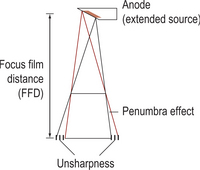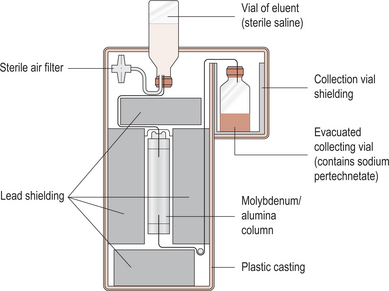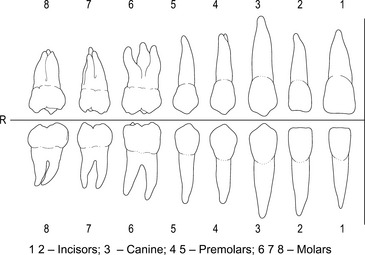T
T1 relaxation time (T1, spin-lattice relaxation time, longitudinal relaxation time) in magnetic resonance imaging, the time taken for the spins to give the energy obtained from the initial radio frequency impulse, back to the surrounding environment and return to equilibrium. It represents the time required for the longitudinal magnetization (Mz) to go from 0 to 63% of its final maximum value.
T2 relaxation time (transverse or spin-spin relaxation time) the time required for the transverse magnetization to decay to about 37% of its maximum value and is the characteristic time constant for loss of phase coherence among spins orientated at an angle to the static main magnetic field.
table incrementation time the time taken for the patient’s couch to move from one slice location to the next in sequential (non-spiral) CT scanning.
tabular grains are ‘flattened’ grains that are used only in sensitized film emulsions in screen film technology; they have a large surface area and small volume. The added dye can increase the amount of absorption resulting in a high-speed, high-resolution film with relatively low silver coating weights.
tachycardia excessively heart beat (in excess of 100 beats per minute in adults). Can occur following shock, haemorrhage, heart condition, hyperthermia or the action of certain drugs.
tachypnoea rapid, shallow respiration.
tactile relating to the sense of touch. See also taenia.
taenia coli three flat bands running the length of the large intestine and consisting of the longitudinal muscle fibres.
talipes any of a number of deformities of the foot and ankle.
talipes calcaneovalgus a condition usually caused by intrauterine posture. The foot has been fixed in an upturned position with the sole against the uterine wall. Improvement and usually complete recovery occurs with active movement after birth.
talipes equinovarus (club foot) the heel is drawn up, the foot inverted and the hindfoot adducted.
talus situated between the tibia proximally and the calcaneus distally, thus directly bearing the weight of the body. It is the second largest bone of the ankle.
tangential when a beam enters the body at an angle to avoid critical structures, for example, in the treatment technique for carcinoma of the breast.
target thin tungsten plate on the anode of an X-ray tube which, when bombarded with electrons, produces X-rays.
target angle the angle between the X-ray beam and the face of the target, the target of an X-ray tube is set at an angle to maximize the target area and minimize the geometric unsharpness.

Target angle and geometric unsharpness.
From Radiographic imaging, 3rd edn, Chris Gunn, 2002, Churchill Livingstone, Edinburgh, with permission.
target organ the organ that a dose of radiation is calculated for.
tarsal bones short bones, the seven bones which lie between the metatarsal bones and the ankle joint in the foot.
tarsal coalition (peroneal spastic flat foot) an anomaly in which adjacent tarsal bones are fused together. Fusion may be bony or cartilaginous. The most common occurs between the calcaneus and the navicular with union across the mid-tarsal joint. Talocalcaneal coalition also occurs.
tarsometatarsal relating to the tarsal and metatarsal region.
tarsus the seven small bones of the foot. The dense connective tissue found in each eyelid, contributing to its form and support.
taste (gustation) a chemical sense closely linked with smell.
taste buds sensory receptors found on the tongue, epiglottis and pharynx.
tattoos permanent skin markings to facilitate accurate daily set up of patients during a course of radiotherapy.
TE (echo time) the time between the centre of the excitation pulse and the peak of the echo.
tears the secretion produced by the lacrimal gland. Tears contain the bactericidal enzyme lysozyme.
technetium (Tc) a radioactive element which is produced by irradiation of molybdenum, an isotope of technetium (99Tcm) is used in radionuclide imaging for brain scanning.
technetium generator used to produce radionuclides artificially by bombarding the nuclei of elements with particles. Molybdenum-98 is placed in a neutron stream and neutrons are absorbed to produce molybdenum-99 which results in the emission of gamma rays; the molybdenum decays to form technetium-99m and this is removed from the generator as sodium pertechnetate which is used for radionuclide imaging.

Principal features of a technetium-99m generator.
From Principles of radiological physics, 3rd edn, D T Graham, 1996, Churchill Livingstone, Edinburgh, with permission.
teeth the 32 adult (see figure on p. 370) or 20 childhood teeth lie in the alveolar ridge of the mandible and the maxilla.
teething lay term for the discomfort during the eruption of the primary dentition in babies.
tegument the skin or covering of the body.
telangiectasia the dilatation of thin-walled, superficial blood vessels.
teleisotope unit equipment containing a radioactive source producing X or γ rays for teletherapy.
telemetry the electronic transmission of data including clinical measurement between distant sites. May be used for cardiac monitoring.
teleradiology the electronic transfer of images and reports to remote centres, for example, general practitioner practices.
Teletex the sending of documents at high speed electronically.
Teletext the non-interactive public information service on television; BBC transmits Ceefax, the ITA transmits Oracle.

Permanent teeth right upper and lower quadrants.
From Bones and joints, 4th edn, Chris Gunn, 2002, Churchill Livingstone, Edinburgh, with permission.
teletherapy when an external source of radiation (X-rays or γ-rays) is directed to a tumour to give the maximum radiation dose to the tumour and the minimum dose to the surrounding healthy tissue.
temple that part of the head situated between the outer angle of the eye and the top of the pinna.
temporal relating to the temple.
temporal bones one on each side of the skull below the parietal bone, containing the middle ear.
temporomandibular relating to the temporal region or bone, and the lower jaw, such as the joint between the temporal bone and mandible.
temporomandibular joint (TMJ) syndrome pain in the region of the temporomandibular joint frequently caused by malocclusion of the teeth, resulting in malposition of the condylar heads in the joint and abnormal muscle activity, and by bruxism.
tendinitis inflammation of a tendon.
tendon a band of white, fibrous connective tissue that joins muscle to bone.
tenesmus a feeling of incomplete emptying of the bowel.
tennis elbow a painful condition affecting the extensor muscle of the forearm at the attachment of the lateral epicondyle of the humerus.
tension pneumothorax a valve-like wound or tear in the lung allows air to enter the pleural cavity with each inspiration, but not to escape on expiration, thus progressively increasing intrathoracic pressure and constituting an acute medical emergency. Signs are of hyperinflation, midline shift and increasing respiratory distress.
tenosynovitis inflammation of the thin synovial lining of a tendon sheath, as distinct from its outer fibrous sheath. It may be caused by mechanical irritation or by bacterial infection.
tenth-value thickness the thickness of a substance that will transmit exactly one-tenth of the intensity of radiation falling on it.
tentorium cerebelli a fold of dura mater between the cerebellum and cerebrum. Damage during birth may result in intracranial bleeding.
teratoma commonly a tumour of the testis or ovary. It is of embryonic origin and usually malignant. Some testicular tumours have both seminoma and teratoma components. The cure rate for germ cell tumours has increased 10-fold with use of platinum-based chemotherapy.
termination of pregnancy (TOP) see abortion.
tesla a unit for measuring the strength of a magnetic field. A magnetic flux density of 1 tesla exists if the force on a 1 metre long straight wire, carrying a current of 1 ampere, is 1 Newton and the wire is placed at right angles to the direction of magnetic flux.
testis a male gonad. One of the two glandular structures contained in the scrotum of the male; they produce spermatozoa and the male sex hormones. undescended testis the testis remains within the bony pelvis or inguinal canal. See also cryptorchism.
testosterone the major androgen, a steroid hormone produced by the testes. It is responsible for the development of the male secondary sexual characteristics and reproductive functioning.
tetradactylous having four digits on each limb.
tetraplegia (quadriplegia) paralysis of all four limbs.
TFT (Thin Film Transistor) the technology used in laptop screens.
thalamus a collection of grey matter at the base of the cerebrum. Sensory impulses from the whole body pass through the thalamus en route to the cerebral cortex.
thalassaemia an inherited disease due to abnormal haemoglobin causing haemolytic anaemias.
thallium activator luminescent centres where about 10–15% of the energy deposited is converted to light energy. Used with sodium iodide as a scintillator crystal.
theca an enveloping sheath, especially of a tendon, or the dura mater.
thenar relating to the palm (hand) and the sole (foot). thenar eminence the palmar eminence below the thumb.
therapeutic ablation a dose of radiation given to destroy harmful tissue.
therapeutic abortion see abortion.
therapy verification film an X-ray film shielded by a lead sheet, which is placed behind the patient during one treatment to verify the area being treated. See also portal imaging.
thermal capacity the heat energy in joules which is required to raise the temperature of the body by 1 kelvin unit.
thermal effect of ultrasound the heating of tissue by breaking down the air bubbles and cavities in the tissues.
thermionic emission the process of releasing electrons from an emitter.
thermionic emitter a substance that releases electrons when heated.
thermographic printing utilizes a film containing silver behenate that when exposed to light the resultant heat activates the silver and produces the image. See also photo-thermographic printing.
thermography an investigation that detects minute temperature differences over different body areas by use of an infrared thermograph that is sensitive to radiant heat. The uses include the study of blood flow and detection of cancers, such as breast cancer.
thermoluminescence a substance that when irradiated stores energy, when heated photons of light are produced in proportion to the energy stored.
thermoluminescent dosimetry small disks containing lithium fluoride can be attached to a patient’s body, the disks are then heated and the amount of light produced is compared to a standard to ascertain the amount of radiation received by the patient. A badge containing two lithium fluoride disks worn by radiation workers to estimate the radiation dose they have received to the skin and the whole body dose.
thermometer equipment for measuring temperature.
thermostat equipment for controlling temperature.
thoracic associated with the thorax.
thoracic cage framework of bones that protects the thoracic structures and provides muscle attachments.
thoracic duct a channel conveying lymph (chyle) from the cisterna chyli in the abdomen to the left subclavian vein. thoracic inlet syndrome (cervical rib) a supernumerary rib in the cervical region, which may present no symptoms or it may press on nerves of the brachial plexus.
throracic vertebrae the 12 bones of the spine that articulate with the ribs.
Thoraeus filter see compound filters.
threatened miscarriage loss of pregnancy characterized by slight vaginal bleeding while the cervix remains closed.
three-dimensional reconstruction a digitally produced image that shows the depth, height and width of an object or objects.
three-dimensional ultrasound the creation of a computerized, reconstructed ultrasound image which represents the anatomical structure being investigated, for example, used to visualize the fetal face and the adult heart valves.






